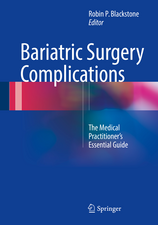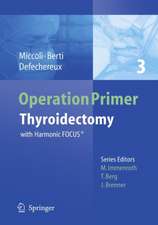Minimally Invasive Neurosurgery and Neurotraumatology
Editat de Tetsu Kannoen Limba Engleză Paperback – 9 noi 2010
| Toate formatele și edițiile | Preț | Express |
|---|---|---|
| Paperback (1) | 994.75 lei 38-44 zile | |
| Springer – 9 noi 2010 | 994.75 lei 38-44 zile | |
| Hardback (1) | 1113.99 lei 6-8 săpt. | |
| Springer – 26 dec 2005 | 1113.99 lei 6-8 săpt. |
Preț: 994.75 lei
Preț vechi: 1047.10 lei
-5% Nou
Puncte Express: 1492
Preț estimativ în valută:
190.37€ • 198.01$ • 157.16£
190.37€ • 198.01$ • 157.16£
Carte tipărită la comandă
Livrare economică 11-17 aprilie
Preluare comenzi: 021 569.72.76
Specificații
ISBN-13: 9784431998136
ISBN-10: 4431998136
Pagini: 432
Ilustrații: 280 p.
Dimensiuni: 155 x 235 x 23 mm
Greutate: 0 kg
Ediția:Softcover reprint of hardcover 1st ed. 2006
Editura: Springer
Colecția Springer
Locul publicării:Tokyo, Japan
ISBN-10: 4431998136
Pagini: 432
Ilustrații: 280 p.
Dimensiuni: 155 x 235 x 23 mm
Greutate: 0 kg
Ediția:Softcover reprint of hardcover 1st ed. 2006
Editura: Springer
Colecția Springer
Locul publicării:Tokyo, Japan
Public țintă
Professional/practitionerDescriere
Neurotraumatology patients present an enormous challenge to society. Neuros- gical management of brain and spinal cord injury has been a frustrating area, as s- gical methods, especially in moderate and severe injuries, have been limited to control of brain and spinal compression, control of intracranial pressure with its expected effect on cerebral blood flow, and structural repair of the supporting structures (skull, spine, brain and spinal cord coverings). Achieving the best outcome for the neu- traumatology patient, however, requires much more than that. This important issue has thus far been approached through the broadest spectrum of scientific knowledge, from the most fundamental biological sciences to the social sciences. Such a variety of approaches has for a long time been in need of a "center of gravity;' a balancing point where facts and opinions can meet and be integrated. The management of neural injury is awaiting a breakthrough, and we should do our best to facilitate. As the majority of the new discoveries tend to appear at the integrating borderlines of two separate scientific areas, our duty is to bring together all scientists involved with neural injury. all hope that the meeting has fulfilled this goal and is a step forward in bringing together previously distant areas of knowledge in neurotraumatology. These proceedings contain the full text of the submitted reports, with the intention of providing the information and personal opinions of the participating speakers to those who were unable to attend.
Cuprins
Part I: 6th International Congress on Minimally Invasive Neurosurgery The NASA Smart Probe for Real-time Tissue Identification: Potential Applications in Neurosurgery Clinically Non-Functional Pituitary Tumors: The Surgical and Biological Challenge Tips for correct use of navigation Image-guided surgery for gliomas Recent advances in radiosurgery for cerebral arteriovenous malformations: The University of Tokyo experience Intramedullary spinal cord glial tumours: management philosophy and surgical outcome Surgical tactics for subaxial spinal cord injury Efficacy of lateral position on minimally invasive cervical expansive open-door laminoplasty MR Tractography for Minimally Invasive Neurosurgery Intraoperative MRI Clinical significance of positron emission tomography in brain tumor surgery The biology of glioma: A discussion from the standpoint of photodynamic diagnosis and photodynamic therapy MCA embolism local fibrinolytic intervention trial (MELT) Japan Direct cerebral bypass supplements indirect bypass procedures in moyamoya disease Treatment of Cerebral Vasospasm following Subarachnoid Hemorrhage Retrocarotid Infracommunicating Approach for Parasellar and Interpedunclar Tumors Genetically modified cell line grafting for the treatment of Parkinson's disease Controlled secretion of b-endorphin from human embryonic kidney cells carrying a Tet-on-NL1-b-endorphin fusion gene Human Gene Therapy for Malignant Gliomas by In Vivo Transduction with Human Interferon-beta Gene Using Cationic Liposomes Neuronal restoration of memory disturbances and neuroprotection for fall in vegetation after cardiac arrest. Neuroprotection and repair by using adult-derived neural stem cell grafting for neurological disorders Diaphragm Pacing with a Spinal Cord Stimulator Intraoperative monitoring of the corticospinal MEP (D-wave) in brain tumor surgery Functional neurosurgical rehabilitation in craniovertebral junction abnormality: An exemplary case report Functional Electrical Stimulation for Spinal Cord Injury Rehabilitation at the University of Virginia and Duke University Treatment results of poor-grade (WFNS grade V) patients with subarachnoid hemorrhage Minimally invasive spinal surgery using instrumentation Clinical experience with endoscope-controlled removal of intrameatal vestibular schwannomas Neuroprotective approaches in experimental model of cerebral venous infarct Treatment of Ruptured Intracranial Aneurysm: Our Approach Endoscopic Endonasal Transphenoidal Surgery for Pituitary Macroadenoma Microsurgical treatment of posterior cranial fossa tumors via keyhole approaches The NASA Nanoelectrode Array for Deep Brain Stimulation: Monitoring Neurotransmitters and Electrical Activity Plus Precise Stimulation Part II: 3rd World Congress of the Academy for Multidisciplinary Neurotraumatology Phenomenological Aspects of Consciousness: Coma Scale in Chronic Stage (Chronic Coma Scale Score; CCSs) Right Median Nerve Electrical Stimulation for the Vegetative State An Ecologically Valid System for Classifying Severity of Traumatic Brain Injury in Children Some Keys to Neu
Caracteristici
Includes proceedings of concurrent symposia on minimally invasive surgery and neurotraumatology, held in March 2005
Provides valuable insights into the latest innovations in clinical neurosurgery
Reviews advances in minimally invasive neurosurgery over the past couple of decades
Provides valuable insights into the latest innovations in clinical neurosurgery
Reviews advances in minimally invasive neurosurgery over the past couple of decades





















